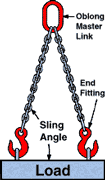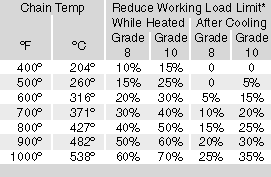 |
|
|
 |
|
|
 |
|
|
Alloy Chain Sling Features
|
- Most durable of all sling types
- Resists sharp edges and abrasions
- Well suited to harsh environments
- Most cost effective sling type for rugged conditions
- Can be fabricated with adjustable reach
- Can be repaired, proof tested, and recertified
- Available in a wide variety of configurations
- More Information
|
|
|
|
Grade 10 Features
|
- A lighter, less expensive sling may be used, based on your current lifts!
- 25% higher working load limits than Grade 8
- Prices are comparable to Grade 8 sling prices
- Exceeds all criteria of OSHA B1984.10
- Reduce risk of overloading - tag at Grade 8 ratings to increase safety factor to 5 or 6 to 1
|
|
|
Grade 8 Sizes and Features
|
|
- Chain sizes from 9/32 to 1-1/4 inch
- Capacities from 3,500 to 187,800 lbs.
- Latch Lok hooks only available in Grade 8
|
|
|
|
Grade 10 Sizes
|
|
- Chain sizes from 9/32 to 7/8 inch
- Capacities from 4,300 to 110,900 lbs.
|
|
|
|
|
 |
|
 |
|
|
| The reach of a chain sling is the working length measured from the load bearing point on the Master Link of the sling, to the load bearing point at the opposite end, when the sling is pulled taut. |
|
|
| F. D. Lake chain slings are mechanically assembled. Cost and lead time for ordering or repair of mechanical chain slings are significantly less than that of equivalent welded slings. |
|
|
|
| Working load limits for comparable welded and mechanical chain slings are equal. However, unauthorized modifications or tampering may be more apparent on welded slings than on mechanical slings. |
|
|
 |
 |
 |
 |
|
|
|
|
 |
|
|
|
Effect of Heat on Chain Slings
|
|
|
| When grade 8 or 10 chain is heated to temperatures in excess of 400° F, the working load limit must be reduced as shown at right. |
| For example, when a grade 8 chain sling is heated to 600° (the chain itself reaching that temperature), its rating, while hot, is reduced by 20 %. |
| After cooling its working load limit is permanently reduced by 5 %. |
| These effects are cumulative, so each time that same chain sling is heated to 600°, its working load limit will be reduced by an additional 5 %. |
| OSHA requires that slings heated to 1,000° F or more must be removed from service. |
|
|
|
|
|
 |
|
|
* Reduction factors are based on our vendors' most
conservative data.
|
|
|
|
Measuring Chain Sling Wear
|
|
|
| A set of calipers can be used to measure the link material diameter and compare it to minimum allowable diameter in the table at right. If there are signs of wear, the diameter of the worn chain link should be measured at the point of the greatest wear. Rotate the calipers around the link material to insure that the smallest possible diameter of the wear point is measured. |
| If the diameter is less than the minimum value for the chain size on the chart, the sling must be removed from service to be replaced or repaired, if possible, by an authorized chain sling service center, such as F. D. Lake. |
|
Chain wear or "No Go" gauges are available from most chain manufacturers to check the diameter of chain links. We stock Campbell's Alloy Chain Wear Gauges (part number 750-3515).
|
|
Rotate the wear gauge around the link material to insure that the smallest possible diameter of the wear point is being measured If the slot of the gauge for the selected size of chain fits over the worn point of the link at the point of greatest wear, the link is worn beyond acceptable safety standards and the sling must be removed from service to be replaced or repaired, if possible, by an authorized chain sling service center.
|
|
|
|
|
 |
|
 |
|
|
|
|
|
 |
|
|
 |
|
 |
|
|
|
|
|
|
|
|
|
|
|
|
|
|
|
|
|
|
|
|
|







